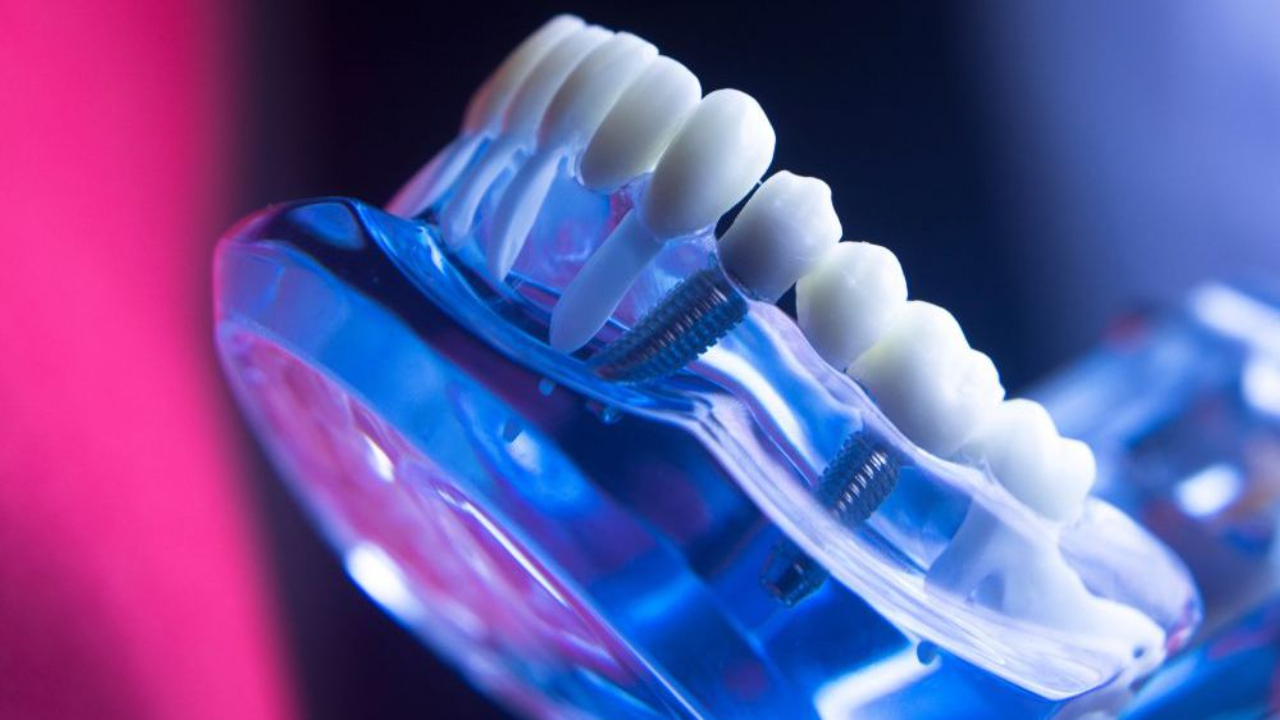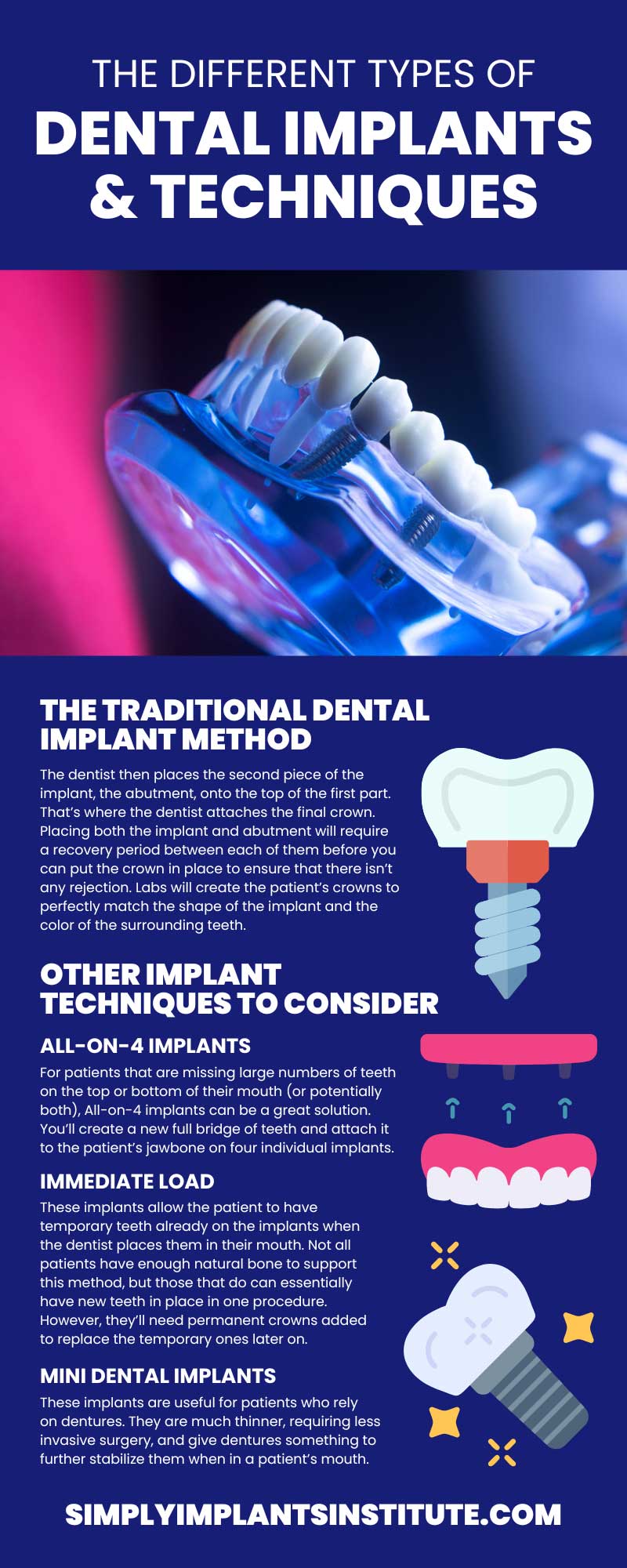The Different Types of Dental Implants & Techniques

As dental implants continue to become a widespread solution for many different oral problems, more dentists than ever before are exploring how they can help patients with them. Placing dental implants is simple once you get enough practice, but you can’t do the same procedure on every patient. The implant itself may even look different depending on the patient’s needs.
For dentists who have only dipped their toes into the waters of dental implants, it can seem like there’s a lot to learn about. However, the different types of dental implants and techniques for placing them are there to offer you and your patients more options. What method or material you decide to lean into is up to you as a professional.
We’ll go through some of the most common implant types and techniques for placing them so that you can get a clear overview of everything that you need to know.
The Major Positioning Types of Implants
The main methods of positioning implants are endosteal and subperiosteal implants. You must have a strong understanding of the patient’s jaw health and bone density to know when you should use one over the other. Your patient may prefer one over the other, so ensure you go over their options with them.
Endosteal Implants
For the most part, you will rely on endosteal implants to fully seat the implants in the jawbone. There must be enough healthy bone tissue to support the implant, which isn’t always the case when dealing with patients who have been without some teeth for a long time. In most cases, it’s worth the extra time to perform a bone graft to build up the jawbone enough for an endosteal implant. As the implant fuses with the patient’s natural bone, it helps to prevent further jawbone decay.
Subperiosteal Implants
As the name implies, dentists place subperiosteal implants underneath the patient’s gums. Dentists don’t fully seat these implants in the patient’s jawbone. Rather, subperiosteal implants go above the jawbone or even directly on top of it. For most patients, endosteal implants will be the preferred choice. However, subperiosteal implants are a viable option for a patient with a severely damaged jawbone who either can’t or doesn’t want to undergo a bone grafting procedure.
Zygomatic and Pterygoid Implants
Candidates for these types of implants are patients that already have severe bone loss in the upper jaw due to advanced periodontal disease or dental extractions done without bone grafting. Due to the location of placement, only oral maxillofacial surgeons or dentists with advanced surgical training that they would receive in an advanced residency can do these implants.
In addition, surgeons or dentists that place these implants should have a thorough understanding of “bites and occlusion principles.” This is necessary because the longevity of the restorative products on top of these implants will last longer and function better if the TMJs and muscles are in positive synergy.
Materials Used for Dental Implant Hardware
Dental implant materials have come a long way from their humble beginnings. Nowadays, you’ll find almost every dental implant made from titanium or zirconia crystal. Both are useful because the body will rarely reject them, and they are extremely durable.
Lightweight Titanium Implants
The material with the longest legacy in dental implants is titanium. One of titanium’s best qualities is how easily it fuses with human bone, making it perfect for creating a sturdy bond in the jawbone. Despite how tough titanium is, it’s quite light and doesn’t add significant weight to a patient’s jaw. A potential downside of titanium implants is that the risk of implant failure is slightly higher in patients with autoimmune diseases, such as lupus or type I diabetes.
Crystalline Zirconia Implants
A new and emerging option for dental implants is zirconia, an artificial crystal substance that’s quickly gaining popularity. Zirconia implants come in one solid piece, making it easier and faster to place them compared to other options. While there isn’t a wealth of data yet about how well zirconia implants hold up over long periods, they are currently one of the best alternatives for titanium implants that a patient can get.
Techniques To Prepare a Jaw for Implants
Not every patient’s jaw will be able to handle an implant procedure right away. You may need to rely on these methods to prepare a patient for an implant procedure:
- Sinus lifts: Sinus lifts increase the amount of bone below a patient’s sinus, which can deteriorate due to missing teeth.
- Bone grafting: Bone grafting allows you to graft more bone matter onto parts of the jawbone that have deteriorated over time because of missing teeth or disease.
- Ridge expansion: This is a procedure that widens the patient’s jaw to allow more space for a dental implant.
The Traditional Dental Implant Method
Of all the types of dental implants and techniques currently in use, the most common method involves an endosteal implant made from three titanium parts. The procedure begins by taking the first part of the implant, which resembles a screw, and embedding it into the patient’s jawbone to act as the tooth’s root.
The dentist then places the second piece of the implant, the abutment, onto the top of the first part. That’s where the dentist attaches the final crown. Placing both the implant and abutment will require a recovery period between each of them before you can put the crown in place to ensure that there isn’t any rejection. Labs will create the patient’s crowns to perfectly match the shape of the implant and the color of the surrounding teeth.
Other Implant Techniques to Consider
There are a few other common techniques that may take the place of the traditional method for some patients. Some of these techniques are faster than the traditional method, while others are more suited to unique cases that require more than a few implants.
All-on-4 Implants
For patients that are missing large numbers of teeth on the top or bottom of their mouth (or potentially both), All-on-4 implants can be a great solution. You’ll create a new full bridge of teeth and attach it to the patient’s jawbone on four individual implants. This product is only for patients that have existing severe bone loss.
Immediate Load
These implants allow the patient to have temporary teeth already on the implants when the dentist places them in their mouth. Not all patients have enough natural bone to support this method, but those that do can essentially have new teeth in place in one procedure. However, they’ll need permanent crowns added to replace the temporary ones later on.
Mini Dental Implants
These implants are useful for patients who rely on dentures. They are much thinner, requiring less invasive surgery, and give dentures something to further stabilize them when in a patient’s mouth.
No matter what your familiarity with these procedures is at the moment, Simply Implants Institute offers dental implant certification courses that provide necessary, hands-on experience to get you comfortable enough to perform them yourself. Understanding these procedures is only the first step, and we can help you develop the practical skills that will help you translate that knowledge into better care for your patients.

